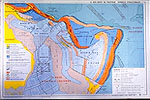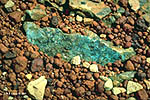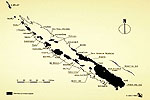 Garden Home |
Research Home
Garden Home |
Research Home Garden Home |
Research Home
Garden Home |
Research Home
Structural geology of New Caledonia and the SW Pacific (source: Atlas de la Nouvelle-Calédonie. ORSTOM, Paris).
The evolution of New Caledonia's flora and vegetation has been strongly influenced by its geological and tectonic history (Guillon, 1974; Lapouille, 1981; Lillie and Brothers, 1970; Paris, 1981a, b). New Caledonia separated from Australia about 65 million years ago, and drifted to the northeast, reaching its present position about 50 million years ago (Coleman, 1980; Raven, 1980). During the Tertiary large parts of New Caledonia underwent a series of submersions, and by the late Eocene nearly all of the island was covered with up to 2,000 meters of peridotites, a type of igneous rock formed from ocean crust that was slowly over-thrust during the preceding tectonic movement (Guillon, 1975; Moores, 1973; Paris et al., 1979).
Geologists claim that during at least some of this period all of the New Caledonia must have been below the ocean surface. Inference from the modern flora, however, indicates that at least some land must have remained exposed, serving as a refugium. Many attributes of New Caledonia's flora, such as its high generic and familial diversity, and the presence of numerous primitive groups, would be very difficult to explain otherwise (e.g., by long-distance dispersal). A substantial component of today's flora is thus thought to comprise the descendants of pre-Eocene Australasian groups that were able to survive on New Caledonia as it separated and drifted away from Australia.


The extensive ultramafic substrates (peridotites and serpentinites) that once covered nearly all of Grande Terre and its associated islands have been reduced by erosion (Guillon, 1969, 1975; Guillon and Routhier, 1971; Trescases, 1969, 1975), but today still cover about 5,500 km², or about one third of the total land area (Jaffré et al., 1987). These have given rise to New Caledonia's characteristic ultrabasic soils (Latham, 1975a, b, c, 1981, 1986; Latham et al., 1978), which have exceptionally high levels of Fe, Mg, and of several heavy metals such as Ni, Cr, Co, and Mn, elements that are generally toxic to plants, along with very low levels of N, P, K, Ca, and Al (Jaffré, 1976; Jaffré et al., 1987). These chemical imbalances result in highly specialized edaphic conditions that have had a profound influence on the evolution and diversification of New Caledonia's flora and vegetation (Jaffré, 1980; Jaffré and Latham, 1974; Jaffré et al., 1970; Lee et al., 1977a; see also below).